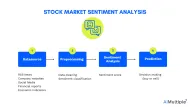Based on our analysis of deep learning applications in finance, we’ve identified 11 key use cases where AI-driven models are making an impact.
These examples are drawn from real-world implementations across financial institutions and cover areas such as fraud detection, risk assessment, and investment strategies.
Top 11 Use Cases of Deep Learning in Finance
1. Customer Service
Financial services companies use finance-specific chatbots with deep learning models to improve user experience. Deep learning in finance solutions brings personalized services to customers. According to the customer’s financial activities, virtual assistants can
- automate frequently completed actions
- suggest products that are not used by the customers, but can be a good fit for them
- answer questions
Deep learning in finance algorithms can identify potential churn by analyzing interactions. This capability helps insurance/insurtech companies and banks to offer discounts and new plans and protect their customer base.
2. Financial Security and Compliance
Deep learning in finance algorithms are effective for
- revealing suspicious transactions with high precision in real time
- Using unstructured data (e.g. satellite and street view images) to check the existence of a business or to perform other compliance controls
This provides advantages such as
- reduction of operational cost
- improvement of regulatory compliance
3. Insurance Underwriting
Insurance companies use historical consumer data to train deep learning algorithms. This consumer data includes health records, information gathered from wearable devices, potential health issues, age, income, profession, loan payment history, etc. Deep learning based solutions help the sector to
- predict and reduce risks
- set suitable premiums
- improve speed and accuracy of underwriting processes.
To learn more, you can check our article on how AI improves underwriting processes.
4. Insurance Claims
Thanks to computer vision and document processing capabilities, deep learning in finance models allow insurance companies to asses damages for car accident claims and risks for home insurance.
Also, these models can identify fraudulent claims more accurately.
5. Lending
Deep learning in finance models uses learned patterns and document processing results to assess credit risks and loan requests.
This data covers income, occupation, age, financial assets, credit scores, overdrafts, outstanding balance, foreclosures, and loan payments. Then, they can decide on the client’s qualifications for lending.
6. Algorithmic Trading
By analyzing historical data & current price movements, and extracting information from the news simultaneously, deep learning algorithms can predict stock values more accurately.
These predictions are used for fast trading decisions. Due to lack of emotions, predictions, and decisions, deep learning in finance models delivers are more neutral/objective and data-driven.
Deep learning algorithms analyze historical market data, real-time financial news, and macroeconomic trends to predict price movements. They are often used to:
- Automate trade executions based on predictive models.
- Optimize portfolio performance by identifying and capitalizing on profitable opportunities.
Quantitative hedge funds utilize deep learning models, such as long short-term memory (LSTM) networks, to make split-second trading decisions based on real-time data streams.
For more, feel free to read our comprehensive list of AI use cases in finance.
7. Customer Support via Chatbots
Deep learning in finance enables AI chatbots to handle customer inquiries in natural, conversational language. Models like transformer-based architectures (e.g., GPT) are used to:
- Understand and respond to complex customer queries.
- Automate routine tasks such as account balance checks or transaction disputes.
- Cost savings by reducing the reliance on human agents.
- Improved customer satisfaction through 24/7 support availability.
Financial platforms, such as Bank of America’s Erica chatbot, utilize deep learning to deliver personalized financial advice and resolve issues efficiently.
8. Portfolio Optimization
To optimize portfolios dynamically, deep learning in finance models evaluates market conditions, risk tolerance, and investment goals. These models:
- Predict asset price movements using historical data and news sentiment.
- Suggest the best asset allocation strategies for maximum returns with minimized risks.
- Enhanced investment strategies tailored to individual needs.
- Real-time rebalancing of portfolios to capitalize on emerging opportunities.
Wealth management platforms utilize deep reinforcement learning to simulate various market conditions and generate robust portfolio recommendations.
9. Regulatory Compliance and Reporting
Deep learning in finance automates compliance monitoring by:
- Analyzing transactional data to detect regulatory violations.
- Generating accurate reports for audits and regulatory submissions.
- Reduces the risk of penalties by ensuring adherence to complex regulations.
- Automates repetitive tasks, saving time and operational costs.
Global banks deploy deep learning systems to identify and report suspicious activities under Anti-Money Laundering (AML) laws, improving regulatory compliance efficiency.
10. Credit Scoring and Risk Assessment
Deep learning in financial models evaluates creditworthiness using both traditional and alternative data sources, thereby improving inclusivity and accuracy in lending decisions.
- Leverages alternative data, such as social media activity and spending habits.
- Enhances credit risk modeling by identifying subtle behavioral patterns.
- Reduces bias in traditional credit scoring methods.
- Expands access to credit for underserved populations.
Real-Life Example:
Zest AI leverages deep learning in finance to develop more inclusive and accurate credit scoring models, enabling lenders to serve a broader customer base.
11. Anti-Money Laundering (AML)
Anti-money laundering (AML) is a critical area of deep learning in finance, requiring sophisticated tools to identify and prevent illicit activities.
Deep learning has become indispensable in strengthening AML efforts by analyzing complex transaction data, identifying anomalies, and mapping intricate financial networks that traditional methods often miss.
- Detects suspicious transaction patterns in real-time: Deep learning models can instantly process vast amounts of transactional data, flagging unusual activities such as sudden spikes in transaction volume or irregular account activity across multiple jurisdictions.
- Identifies complex money laundering networks through graph analysis: Using advanced graph-based neural networks, deep learning tools uncover hidden connections between accounts, entities, and transactions. This capability is crucial for detecting multi-layered laundering schemes that involve numerous intermediaries.
- Flags high-risk accounts and transactions for further investigation: Algorithms prioritize flagged activities, categorizing them by risk level, and sending alerts to compliance teams. This ensures that financial institutions focus on the most critical threats.
- Supports regulatory compliance with automated reporting: Deep learning systems streamline AML compliance by generating comprehensive, accurate reports for regulators. These reports include suspicious activity details, supporting documentation, and the rationale behind flagged transactions.
Real-Life Example:
Quantexa, a leading AML solution provider, leverages deep learning to analyze transaction data and map relationships between entities. Using contextual AI, Quantexa uncovers hidden money-laundering networks, helping financial institutions proactively mitigate risks and comply with global AML regulations like the Bank Secrecy Act and FATF standards.
Challenges
Banks are traditionally risk-averse institutions since they have suffered significantly in financial crises when risky bets led to bank failures. For example, in the area of lending, this has led to the boom of fintechs focused on lending, like SoFi.
In addition, banks and insurers are highly regulated institutions and need to be able to show that for example their lending or underwriting decisions do not exhibit bias.
Therefore, deep learning’s challenges (i.e. hard to explain predictions) pose unique challenges for banks.
If you are ready to use deep learning in your 66firm, we prepared a data-driven list of companies offering deep learning platforms.
For more on how technology is transforming financial services, learn about
FAQ
1. What is deep learning, and how is it used in finance?
Deep learning is a subset of artificial intelligence that uses neural networks to analyze and process large amounts of data. In finance, it is used for tasks like fraud detection, risk management, algorithmic trading, and customer personalization by identifying patterns and making highly accurate predictions.
2. Why is deep learning relevant in finance?
Finance deals with both structured and unstructured data such as documents and text. Deep learning allows financial firms
to convert unstructured data into structured, machine-readable data. For example, this allows banks to get financial information on companies from their annual reports published in regulatory platforms like the Companies House in the UK
to make predictions & classifications on structured data. Data such as stock market information is highly structured and can be used to automate trading activities
3. How does deep learning in finance improve fraud detection?
Deep learning models can analyze vast amounts of real-time transaction data, detecting anomalies and suspicious patterns. This helps financial institutions identify fraudulent activities quickly and reduce false positives, ensuring better security and customer trust.
4. What are the latest innovations in deep learning for finance?
Recent innovations include Transformer-based models for analyzing financial texts, federated learning for collaborative data analysis without compromising privacy, and advanced graph neural networks for detecting complex fraud or money laundering schemes.
5. How does deep learning help with compliance in finance?
Deep learning in finance automates compliance processes by generating accurate reports, monitoring suspicious transactions, and ensuring adherence to global regulations such as AML and KYC guidelines. This reduces manual workloads and ensures regulatory readiness.
If you need help in choosing among deep learning vendors who can help you get started, let us know:
This article was drafted by former AIMultiple industry analyst Ayşegül Takımoğlu.



Comments
Your email address will not be published. All fields are required.